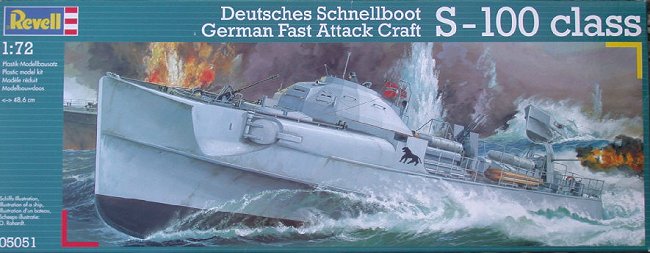
|
KIT: |
Revell AG 1/72 German S-Boat |
|
KIT # |
5051 |
|
PRICE: |
$14 in Germany |
|
DECALS: |
Three Boats |
|
REVIEWER: |
|
|
NOTES: |
A beauty of a kit; on par with Japan's best, but MUCH less expensive. |

|
HISTORY |
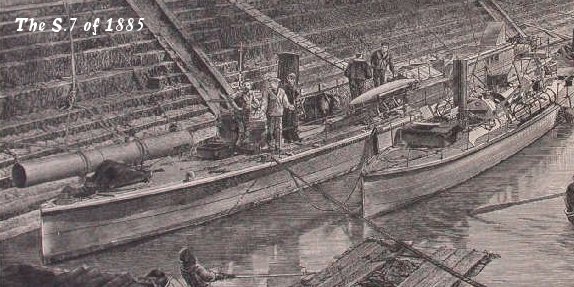 As warships have evolved,
torpedo boats have always been on the cutting edge of technology. Small crafts,
very fast and agile, using hit-and-run tactics, offering only a small target /
radar signature, highly mobile up to being able to be transported by rail,
virtually all navies have used these craft.The german Schnellboote of WW
II are widely considered very good and balanced constructions, in fact a lot of
the surviving boats (107 in all) were gladly used by foreign navies for a number
of years after the war (Denmark alone took 20). The british called these craft
E-boat for enemy war motor boats, and they are best known internationally under
this name. Similar constructions of other navies were the
American PT boat and the
british Vosper MTB.
As warships have evolved,
torpedo boats have always been on the cutting edge of technology. Small crafts,
very fast and agile, using hit-and-run tactics, offering only a small target /
radar signature, highly mobile up to being able to be transported by rail,
virtually all navies have used these craft.The german Schnellboote of WW
II are widely considered very good and balanced constructions, in fact a lot of
the surviving boats (107 in all) were gladly used by foreign navies for a number
of years after the war (Denmark alone took 20). The british called these craft
E-boat for enemy war motor boats, and they are best known internationally under
this name. Similar constructions of other navies were the
American PT boat and the
british Vosper MTB.
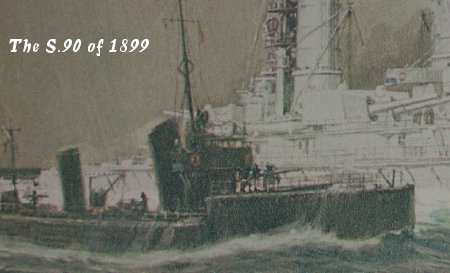 In the overall evolution of
warships, a major resizing took place since the navies cut down the sails.
During the final decades of the 19th century, small attack craft
armed with torpedoes were developed to counter the lumbering battleships. Over
the years, these boats grew larger and larger, until they evolved into the
destroyer. The early german torpedo boat S7 from 1885 displaced 86 tons
at a length of 38 m (see pic). In 1899, S 90, the first german
Hochseetorpedoboot was launched, the term meaning that the craft was really
seaworthy on its own. It displaced 310 tons at a length of 63 m (see pic s90).
These ships were capable of global operations, appropriate logistics provided.
S90 met its fate in 1914 at Tsingtao in China. The last series of Torpedo boats
before the war were already true destroyers with a displacement of 1843 tons.
Smaller torpedo boats were used at the dutch coast during the war (see pic of
A68). The small post war german navy built its first new torpedo
In the overall evolution of
warships, a major resizing took place since the navies cut down the sails.
During the final decades of the 19th century, small attack craft
armed with torpedoes were developed to counter the lumbering battleships. Over
the years, these boats grew larger and larger, until they evolved into the
destroyer. The early german torpedo boat S7 from 1885 displaced 86 tons
at a length of 38 m (see pic). In 1899, S 90, the first german
Hochseetorpedoboot was launched, the term meaning that the craft was really
seaworthy on its own. It displaced 310 tons at a length of 63 m (see pic s90).
These ships were capable of global operations, appropriate logistics provided.
S90 met its fate in 1914 at Tsingtao in China. The last series of Torpedo boats
before the war were already true destroyers with a displacement of 1843 tons.
Smaller torpedo boats were used at the dutch coast during the war (see pic of
A68). The small post war german navy built its first new torpedo
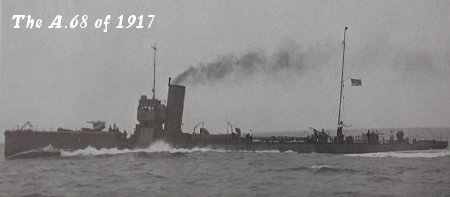 boats betwen 1925 and 1928;
whereas all earlier boats had only had numbers, these were named after birds of
prey (no Klingon connection here?); Albatros and Kondor are shown
in the next pic. They displaced 998 tons and remained pretty similar to their
predecessors. Their successors was the T1-class built during the 1930s after
rearmament began (see next pic T1 and T22 are seen over the bridges of two
Schnellboote) at a similar displacement.
boats betwen 1925 and 1928;
whereas all earlier boats had only had numbers, these were named after birds of
prey (no Klingon connection here?); Albatros and Kondor are shown
in the next pic. They displaced 998 tons and remained pretty similar to their
predecessors. Their successors was the T1-class built during the 1930s after
rearmament began (see next pic T1 and T22 are seen over the bridges of two
Schnellboote) at a similar displacement.
In the 1930s,
the German
navy felt the need for a smaller, yet potent attack
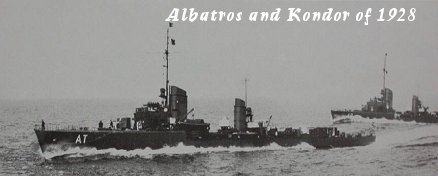 craft of limited range, yet
high speed and small silhouette, smaller than both the destroyer and the T-boat-
Fr. Luerssen shipyard in Bremen-Vegesack at the Weser river designed the
Schnellboot; this design proved to be so sound that it wasnīt basically
changed throughout the war. (see pic of S26 for the early version) The
Schnellboot was about 35 m long and displaced 78 - 100 tons. It was powered by
three supercharged diesel engines, first with 2000 hp each; in the later series
power was increased to 3 x 2,500 hp. Top speed was 43 knots, under WEP even up
to 48.5 knots. The shape of the hull made these boats very seaworthy even under
the rough conditions in the
craft of limited range, yet
high speed and small silhouette, smaller than both the destroyer and the T-boat-
Fr. Luerssen shipyard in Bremen-Vegesack at the Weser river designed the
Schnellboot; this design proved to be so sound that it wasnīt basically
changed throughout the war. (see pic of S26 for the early version) The
Schnellboot was about 35 m long and displaced 78 - 100 tons. It was powered by
three supercharged diesel engines, first with 2000 hp each; in the later series
power was increased to 3 x 2,500 hp. Top speed was 43 knots, under WEP even up
to 48.5 knots. The shape of the hull made these boats very seaworthy even under
the rough conditions in the 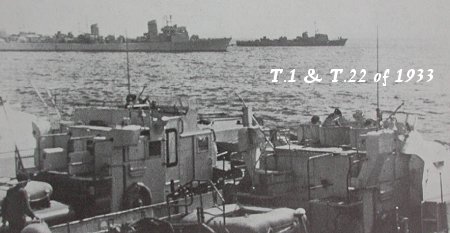 North
Sea and the english channel; they were highly manoeuverable on account of the
clever design of the rudders. Main armament was two torpedo tubes. Apart from
that, the boats could carry either two reserve torpedoes or 6 mines or 6 depth
charges. A number of guns was carried for AA purposes.
North
Sea and the english channel; they were highly manoeuverable on account of the
clever design of the rudders. Main armament was two torpedo tubes. Apart from
that, the boats could carry either two reserve torpedoes or 6 mines or 6 depth
charges. A number of guns was carried for AA purposes.
During the war,
the boats were improved with more power, more AA guns and more armor. This new
version was the S-100 class depicted in this model kit. Most visible external
difference is the redesigned higher bow and bridge. The latter was armored with
10-12 mm of steel and shaped like a dome or a cupola. In german, these boats
were called Kalottenboote on account of this peculiar shape. The crew was
increased from 24 to 30,  mostly
to man the additional AA guns. E-boats were operated from France, the
Netherlands, Germany, Norway, in the Mediterranean, in the Baltic, whereever the
need and opportunity arose. The growing allied air and radar superiority made
their operations ever more difficult and costly as the war progressed. They were
never equipped with radar, only late in the war with the Naxos radar
warning receiver.
mostly
to man the additional AA guns. E-boats were operated from France, the
Netherlands, Germany, Norway, in the Mediterranean, in the Baltic, whereever the
need and opportunity arose. The growing allied air and radar superiority made
their operations ever more difficult and costly as the war progressed. They were
never equipped with radar, only late in the war with the Naxos radar
warning receiver.
|
THE KIT |
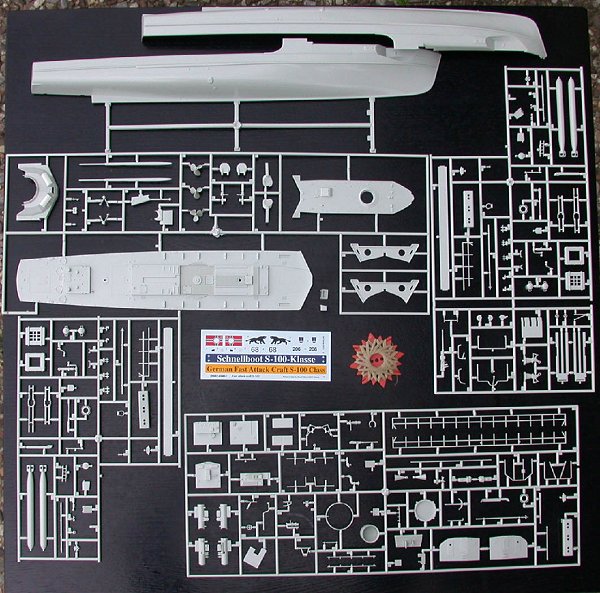
Airfix has produced a kit of an early E-boat about 30 years ago, and itīs still around. I canīt coment on it but Iīve included a link to a preview of that kit. Itīs surely adequate and if I remember my Vosper MTB of the 70s, it must be a nice kit and fun to build.
What can I say
about this kit? Itīs yet another highly recommendable Revell of Germany kit.
Itīs definitely on par with Tamigawa: Itīs very crisply molded, finely detailed,
the instructions are adequate, you wonīt find flash nor ugly sink marks
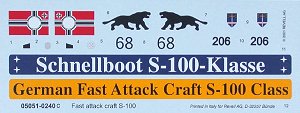 and from what Iīve read,
building it should be a breeze. The large sprues are packed separately, and
there are even little foam buffers on the bridge to prevent the parts from being
scratched. You get very nice rigging thread and a set of decals for three boats
plus a transparent plastic sheet for the windbreaker on the bridge. And this kit
is very adequately prized. Itīs real value for money. In my opinion, you wonīt
need much aftermarket stuff. Some scratchbuilding and a good look into your
spares box should help.
and from what Iīve read,
building it should be a breeze. The large sprues are packed separately, and
there are even little foam buffers on the bridge to prevent the parts from being
scratched. You get very nice rigging thread and a set of decals for three boats
plus a transparent plastic sheet for the windbreaker on the bridge. And this kit
is very adequately prized. Itīs real value for money. In my opinion, you wonīt
need much aftermarket stuff. Some scratchbuilding and a good look into your
spares box should help.
|
CONCLUSIONS |
As far as Iīm concerned, Iīll build it pretty soon. You might even think of motorizing it and installing R/C, but Iīd rather opt for a nice weathering job and keep it static. I havenīt started browsing through paint schemes yet, but Iīm aware there are some weird schemes around. If you can do without the behemoth Andrea 1/32 Type VII submarine, one or more S boats might not look half that bad in a diorama. And 1/72 is a common scale for vehicles, too.
|
REFERENCES |
Iīve done some surfing; beware, some of it is in German:
http://www.prinzeugen.com/SBOATIND.htm
http://www.geocities.com/Pentagon/Barracks/1041/eboat.html
http://www.hkmodeler.com/scale/ships/eboat.htm
http://www.schnellboot.net/de/km/s100/revell72/index.html
http://www.wlb-stuttgart.de/seekrieg/km/sboot/sfl-frames.htm
- Hans Juergen Hansen : Die Schiffe der deutschen Flotten 1848-1945, Oldenburg 1977 (pics)
If you would like your product reviewed fairly and quickly where it will be seen by well over 150,000 visitors a month, please contact me or see other details in the Note to Contributors.